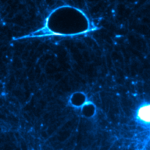Link to Pubmed [PMID] – 33817838
Link to DOI – 10.1096/fj.202002492R
FASEB J 2021 May; 35(5): e21540
Compared to conventional antisera strategies, monoclonal antibodies (mAbs) represent an alternative and safer way to treat botulism, a fatal flaccid paralysis due to botulinum neurotoxins (BoNTs). In addition, mAbs offer the advantage to be produced in a reproducible manner. We previously identified a unique and potent mouse mAb (TA12) targeting BoNT/A1 with high affinity and neutralizing activity. In this study, we characterized the molecular basis of TA12 neutralization by combining Hydrogen/Deuterium eXchange Mass Spectrometry (HDX-MS) with site-directed mutagenesis and functional studies. We found that TA12 recognizes a conformational epitope located at the interface between the HCN and HCC subdomains of the BoNT/A1 receptor-binding domain (HC ). The TA12-binding interface shares common structural features with the ciA-C2 VHH epitope and lies on the face opposite recognized by ciA-C2- and the CR1/CR2-neutralizing mAbs. The single substitution of N1006 was sufficient to affect TA12 binding to HC confirming the position of the epitope. We further uncovered that the TA12 epitope overlaps with the BoNT/A1-binding site for both the neuronal cell surface receptor synaptic vesicle glycoprotein 2 isoform C (SV2C) and the GT1b ganglioside. Hence, TA12 potently blocks the entry of BoNT/A1 into neurons by interfering simultaneously with the binding of SV2C and to a lower extent GT1b. Our study reveals the unique neutralization mechanism of TA12 and emphasizes on the potential of using single mAbs for the treatment of botulism type A.




